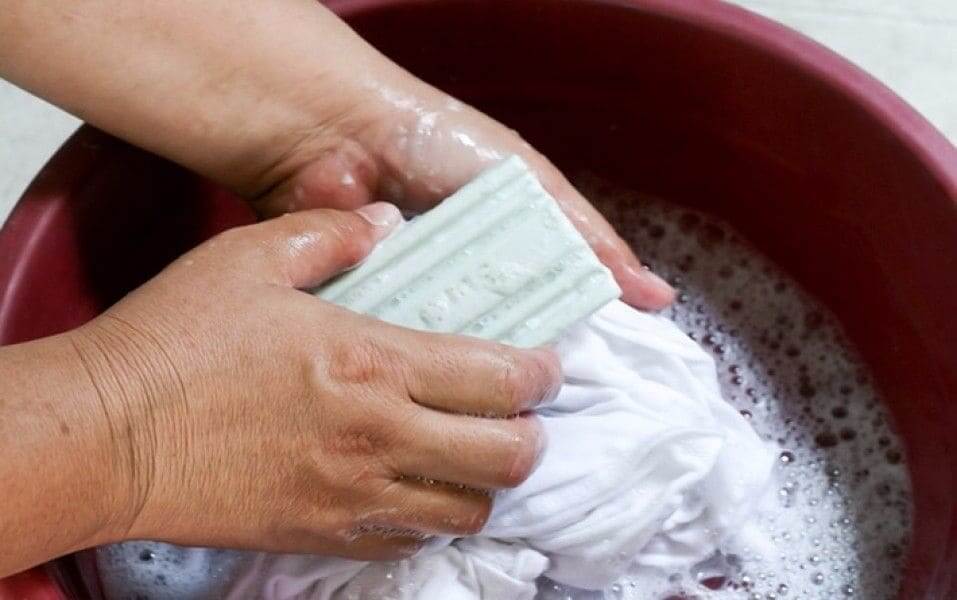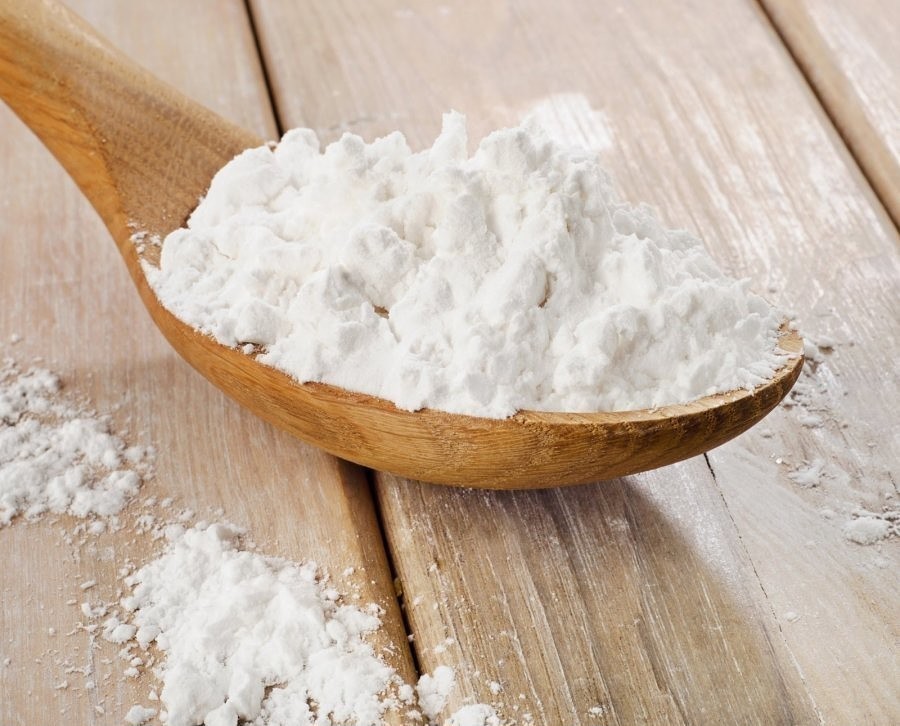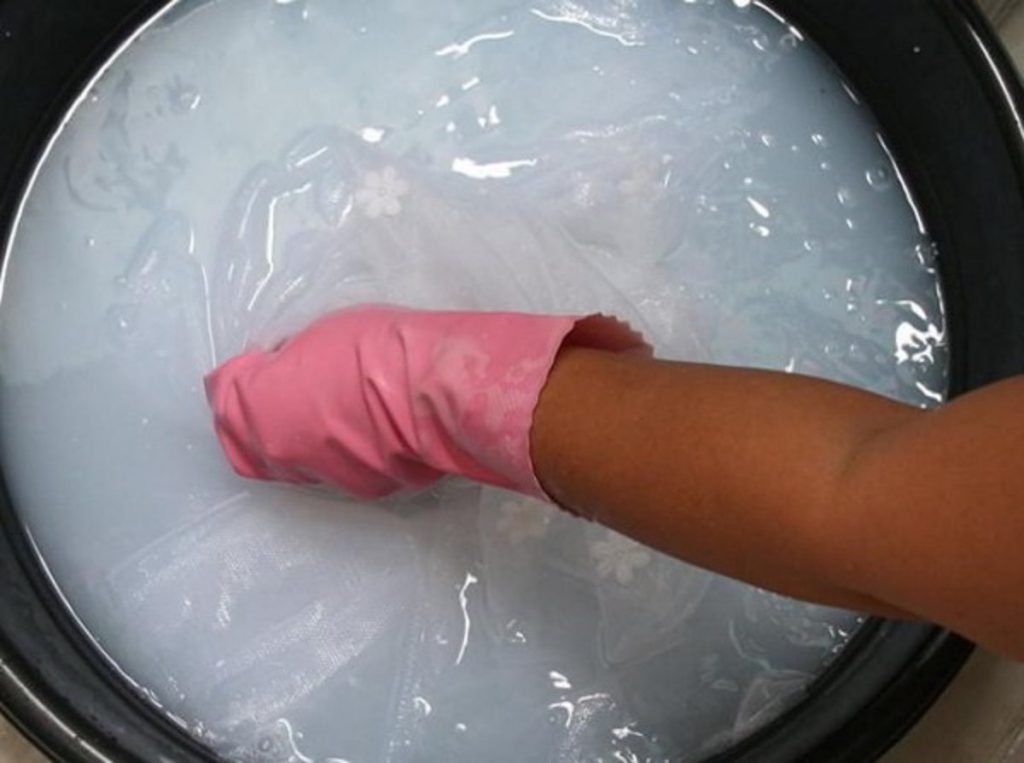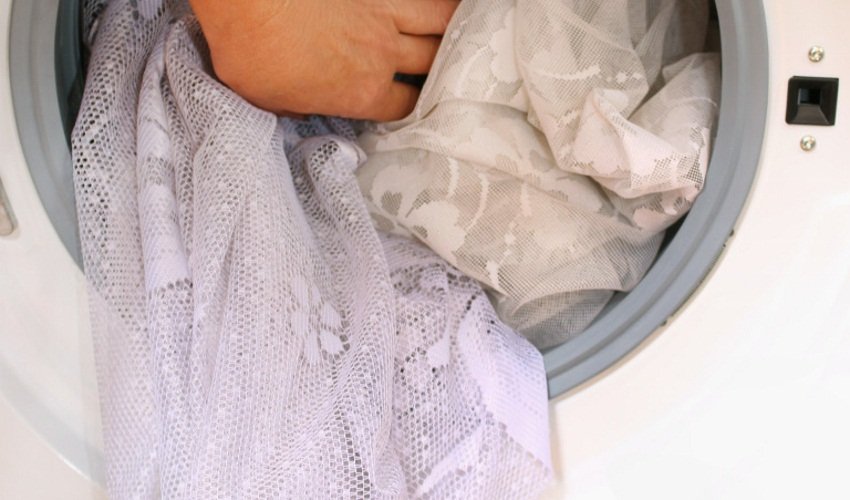How to bleach tulle from dullness
Methods for decorating window openings are becoming more and more diverse, however, the question of how to whiten the tulle from grayness does not lose its relevance. What makes the snow-white material look messy? Are there any ways to get rid of it?
Tulle ... What is it?

Tulle is made from the following types of fabrics: organza, muslin, nets, veils. Organza is characterized by strong twisting of the threads, and the result is a very durable and almost transparent fabric. Previously, such fabric was made exclusively from natural silk threads, however, it was a very expensive pleasure. Organza today is a fabric made of synthetic fibers.

Net. As the name suggests, the distinctive feature of this fabric is the presence of cells. They can be large, medium or small. The canvas perfectly permeates air, but has one unpleasant feature - the tendency to accumulate dust.
Veil is a very delicate, weightless fabric with less transparency. It is this material that is chosen when they are going to design a window opening without thick curtains. A veil made of natural threads looks very impressive, but, unfortunately, in its characteristics it is very inferior to an artificial canvas.

Kiseya or filament curtains are less common than others. Not every style will "accept" such curtains. But if you correctly "fit" muslin into the overall design concept, the room will acquire a special style. Unfortunately, even with very careful use, over time, the snow-white tulle acquires a yellowish tint. There may be several reasons for this:
- Constant exposure to sunlight.
- Tobacco smoke.
- Contact with heating devices.
- Ingress of dirt and dust particles (for example, exhaust fumes from an open window, soot or grease from cooking in the kitchen).
- Other reasons for the appearance of a gray tint:
- Very often, tulle loses its original color simply from old age.
- Due to washing with other colored items.
- Dust settling.
- Frequent wash.
- Wash in hard water.

General washing tips
Before you get acquainted with effective ways to get rid of yellow or gray spots, it is important to understand how to properly wash curtains in general and tulle in particular.
- Before bleaching the curtain, shake it out well and soak it in ordinary soapy water. If this is not done, dirt will remain on the curtain.
- If you wash the curtain by hand, you cannot wring it out. It is enough to lightly shake it and hang it, straightening it well.
- With a machine wash, the spin mode should be turned off altogether.
- In order not to complicate the ironing process, a damp curtain is hung on the cornice. The canvas straightens under its own weight.
- It is not recommended to use chlorine-containing compounds, as they destroy the structure of the fabric and lead to premature wear.

How to bleach tulle
Despite the fact that today the range of ready-made whitening compositions is very large, there are still enough fans of folk (or improvised) remedies.
Ammonia and hydrogen peroxide
This bleaching method has a rich history. For the cleaning solution, mix 1 tablespoon of ammonia, 2 tablespoons of hydrogen peroxide and 5-7 liters of water. Mix everything well, and soak the previously torn curtain in the solution. Soak for 30 minutes. Then rinse in running water and hang to dry.
The main advantages of this method are the cheapness and speed of the process. However, there is a serious nuance: in this way, only cotton curtains can be bleached, and nylon fabrics can be hopelessly damaged.

Laundry soap
There is hardly an easier way than this. To begin with, a soap solution is prepared: rub 100 grams of soap on a medium grater, mix with water and put on fire until a homogeneous mass is formed. After boiling, the mixture is removed from the stove and diluted with cold water to an average temperature comfortable for washing. Then the tulle is left to soak for 5-7 hours. In this case, it is important to ensure that the canvas is completely wet and periodically turn it over in the basin.
After soaking the curtain, it is washed by hand and rinsed in running water. Squeeze lightly and hang to dry.

Salt and soda
Immediately, we note that whitening with these tools is indicated for any fabrics, both natural and synthetic.
First, prepare the bleaching composition: mix 2 tablespoons of salt with 1 tablespoon of baking soda and 1 tablespoon of washing powder. We put everything in a basin with warm water and mix well until the ingredients are completely dissolved. Soak the tulle and leave for 15 minutes. If the cloth is very dirty, increase the soak time to 30 minutes. After that, rinse under warm running water.

Blue
Another substance that is indispensable in the fight against yellow or gray bloom is blue. The main thing here is not to overdo it with dosages. Typically, the solution is prepared as follows: 3 drops of blue in 5 liters of water. Of course, a lot depends on concentration, so the surest way to achieve the desired result is to read the recommendations on the packaging.

Starch
This substance has a whole range of useful properties. So its application will not only make the tulle snow-white, but also give it strength. A glass of starch is diluted in about a liter of water, stirred well and put on fire. The result is a kind of paste. It is added to the basin in which the tulle will be soaked. It is important that the paste is free of lumps. If necessary, the composition can be filtered through cheesecloth.
The pre-washed tulle is soaked for two hours and then dried.
Attention: this method differs from the previous ones in that the tulle is not rinsed after soaking. It is thanks to this that the canvas becomes more durable, and even subsequently gets dirty less.

Zelenka
First, a bleaching solution is prepared: 10 drops of brilliant green and 2 tablespoons of fine salt are poured with one glass of warm water, mixed thoroughly, and then poured into a basin where the tulle will be soaked. If a sediment has formed at the bottom, just do not pour it out, leave it in a glass.
Also, a solution with salt and brilliant green can be added to the washing machine to rinse the tulle.
White
Of course, it's up to you to decide whether to use whiteness or not. Someone is frightened by the high percentage of chlorine (95%), while others are impressed by the result - everything is bleached and in any amount.
Most importantly, do not neglect safety precautions, and work with whiteness only with gloves. First you need to prepare a solution: 3 caps for 7 liters of water. The composition is mixed well and the tulle is soaked for 30 minutes. An important condition: the canvas must be completely in the water. Turn it over if necessary.
After soaking, rinse the tulle well. Experts recommend using whiteness only in extreme cases.

How to remove stains on tulle
In addition to yellowness and grayness, spots spoil the appearance of tulle. These can be just left-over prints, or marks with history.
Remember that "fresh" greasy stains are washed off much easier, so if you notice - immediately get down to action.

What will help:
- Soda and laundry soap. It turns out that these two components complement each other perfectly, not only in the fight against yellow plaque, but also as a stain remover. The cloth is soaked in water with the addition of soda, and then washed with laundry soap.
- Dishwashing liquid. It is quite logical, what other remedy will better cope with fresh greasy stains, if not loved by many "Fairy" or its "relatives".
- Lemon and soda. The algorithm of actions is extremely simple: you need to pour freshly squeezed lemon juice on the stain, and then sprinkle with soda. Wait a little, and then wash as usual.
- Chalk. It turns out that thanks to regular chalk, it becomes possible to get rid of greasy stains. Chop the chalk, sprinkle it on the stain, wait until it absorbs the fat, shake it off and add a new portion of chalk. Continue the procedure until the stain disappears.

If you have to deal with an old greasy stain, then simply soak the tulle in water with the addition of hydrogen peroxide.
Another remedy for greasy stains that are not the first freshness is a mixture of ammonia, vinegar and salt. The ingredients are mixed in a 4: 4: 1 ratio, water is added and the tulle is soaked for 15 minutes. After that, they are washed in the usual way.

How to remove traces of soot and grime
Another question to which housewives often do not know the answer. So, it will take patience and a clear sequence of actions. Such stains are removed in several stages and only in cool water. First, the tulle is soaked and washed with ordinary laundry soap. After that, a soda solution is prepared at the rate of 2 tablespoons of soda per 5 liters of water, the contaminated places are treated with dishwashing detergent and soaked for at least 10 hours.

How to bleach tulle in a washing machine
If there is no time to wash the tulle by hand, entrust this important task to the washing machine. The main thing to remember is that in order for the result to please you and not disappoint you, you should only use special detergents for washing and bleaching.
Procedure:
- Soak the tulle in soapy water.
- Use water with a temperature not higher than 30-40 degrees.
- Be sure to turn off the spin mode.
- Set delicate wash and double rinse.
- Carefully remove the washed tulle from the machine and hang it up.
- Better to use a special laundry bag.

If you do not follow these simple recommendations, then as a result you can get tulle of an incomprehensible color, a changed shape and a loose structure. Finally, be sure to read the tulle care rules that the manufacturer specifies.
Features of washing different types of tulle
As already mentioned, the word "tulle" refers to different fabrics, which means that their care should be individual, suitable for each specific material. Before you start washing, it is important to familiarize yourself with the composition of the linen and with the care recommendations that the manufacturer leaves.

To make organza, veil or chiffon snow-white at home, the fabric is pre-soaked in soapy water for 3-4 hours, while it is very important that the water temperature is not higher than 30 degrees. After that, the tulle is rinsed in plenty of cool water.

Nylon fabrics require a longer soaking - 9-10 hours. Ideally, they should be left to soak overnight. Soaking contains soap, soda and salt. After soaking, the snow-white result is "fixed" with a weak blue solution or starch solution.

If nylon is bleached with whiteness, then it can acquire a yellowish tint or unnecessary rigidity.

To wash muslin requires a certain skill, since the process is complicated by the unusual "appearance" of the cloth. Most often, in order to avoid tangling of the threads, before removing such a tulle from the cornice, it is tied in several places. A regular soap solution is used for washing. It is not recommended to rub the muslin too much, it is enough to squeeze it slightly in warm soapy water.

If the curtains are too dirty, it is best to soak them in soapy water for 15 minutes before washing. And instead of soap, you can use special detergents for washing synthetics.

If you want to wash the cotton curtains in the washing machine, then they must either be tied properly so that they do not get tangled, or placed in a special bag.

In the case when you plan to wash a very expensive and "capricious" tulle, it is better to purchase a special composition for it, in order to avoid unpleasant surprises.

It is quite possible to return the tulle to its original snow-whiteness. This will be helped by both special formulations that are sold in household chemicals stores and improvised means that are available in the arsenal of every housewife.
Video: how to wash tulle correctly and give it its former freshness





